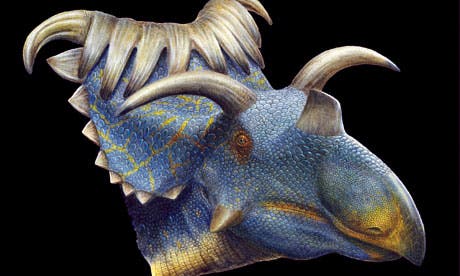Fossil hunters have recently unearthed the fossil remains of a species that can easily claim the title of the horniest dinosaur ever to be found. Kosmoceratops lived some 76 million years ago, in the warm and wet swamps of (what is today) Utah; but what’s really fascinating about him is the fact that he has no less that 15 full size horns on its head.

It’s skull was really huge for their body size (2 meters), and it probably weighed somewhere around 2.5 tonnes. The lesser known relative of the triceratops had a staggering 10 horns on the back of its head, as well as two over its eyes, one over its nose and one from each cheek bone
“These animals are basically oversized rhinos with a whole lot more horns on their heads. They had huge heads relative to their body size,” said Scott Sampson a researcher at the Utah Museum of Natural History
Scientists have long speculated about the purpose of so many horns, and they reached the conclusion that they can only play a decorative part in sexual rituals. So really, what title can be more appropriate than the “horniest dinosaur” ?
“In this case, we think these horns were really about competing for mates and more akin to peacock feathers or deer antlers, where it’s males trying to attract females or intimidate other males,” Sampson said. “Sometimes it’s good to have a way of visually ranking yourself relative to other animals. You can avoid unnecessary conflicts and that is probably what they were doing with all these bony bells and whistles.”
What was also interesting about this species was that females also showcase the same horny display. But paleontologists found an explanation for that too:
“The most obvious explanation is that the females don’t want predators to pick them off so they mimic the males,” he said.
Well the only thing I can add is… this is one nice species !






